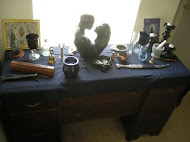Belladonna Belladonna, (Atropa Belladonna), or commonly known as deadly nightshade is usually found in chalky soils, shaded areas and waste ground or old ruins. It is extremely poisonous and has been employed for many centuries for beneficial and less beneficial purposes. According to folklore it is a plant that belongs to the Devil, who tends it. being diverted from this duty only on the night of the Walpurgis night Witches Sabbath. Though widely distributed over Central and Southern Europe, the plant is not common in England, and has become rarer of late years. Although chiefly a native of the southern counties, being almost confined to calcareous soils, it has been sparingly found in twenty-eight British counties, mostly in waste places, quarries and near old ruins. In Scotland it is rare. Under the shade of trees, on wooded hills, on chalk or limestone, it will grow most luxuriantly, forming bushy plants several feet high, but specimens growing in places exposed to the sun are apt to be dwarfed, consequently it rarely attains such a large size when cultivated in the open, and is more subject to the attacks of insects than when growing wild under natural conditions. The name Belladonna, "Beautiful Lady", is thought to derive from its use by Italian ladies, to dilate the pupil of the eye to make them more attractive. The generic name, "Atropa", is derived from the Greek, Atropos, one of the fates that held the shears to cut the thread of human life. The root is thick, fleshy and whitish, about 6 inches long, or more, and branching. It is perennial. The purplish colored stem is annual and herbaceous. It is stout, 2 to 4 feet high, undivided at the base, but dividing a little above the ground into three - more rarely two or four branches, each of which again branches freely.The leaves are dull, darkish green in color and of unequal size, 3 to 10 inches long, the lower leaves solitary, the upper ones in pairs alternately from opposite sides of the stem, one leaf of each pair much larger than the other, oval in shape, acute at the apex, entire and attenuated into short petioles. First-year plants grow only about 1 1/2 feet in height. Their leaves are often larger than in full-grown plants and grow on the stem immediately above the ground. Older plants attain a height of 3 to 5 feet, occasionally even 6 feet, the leaves growing about 1 to 2 feet from the ground. The whole plant is glabrous, or nearly so, though soft, downy hairs may occur on the young stems and the leaves when quite young. The veins of the leaves are prominent on the under surface, especially the midrib, which is depressed on the upper surface of the leaf. The fresh plant, when crushed, exhales a disagreeable odor, almost disappearing on drying, and the leaves have a bitter taste, when both fresh and dry. The flowers, which appear in June and July, singly, in the axils of the leaves, and continue blooming until early September, are of a dark and dingy purplish color, tinged with green, large (about an inch long), pendent, bell-shaped, furrowed, the corolla with five large teeth or lobes, slightly reflexed. The five-cleft calyx spreads round the base of the smooth berry, which ripens in September, when it acquires a shining black color and is in size like a small cherry. It contains several seeds. The berries are full of a dark, inky juice, and are intensely sweet, and their attraction to children on that account, has from their poisonous properties, been attended with fatal results. In September, 1916, three children were admitted to a London hospital suffering from Belladonna poisoning, caused, it was ascertained, from having eaten berries from large fruiting plants of Atropa Belladonna growing in a neighboring public garden, the gardener being unaware of their dangerous nature, and again in 1921 the Norwich Coroner, commenting on the death of a child from the same cause, said that he had had four not dissimilar cases previously. It is said that when taken by accident, the poisonous effects of Belladonna berries may be prevented by swallowing as soon as possible an emetic, such as a large glass of warm vinegar or mustard and water. In undoubted cases of this poisoning, emetics and the stomach-pump are resorted to at once, followed by a dose of magnesia, stimulants and strong coffee, the patient being kept very warm and artificial respiration being applied if necessary. A peculiar symptom in those poisoned by Belladonna is the complete loss of voice, together with frequent bending forward of the trunk and continual movements of the hands and fingers, the pupils of the eye becoming much dilated. The properties of Belladonna depend on the presence of Hyoseyamine and Atropine, the root is the principle source of preparing tinctures, however, the whole plant including the berries contain these alkaloids. Atropine has been used in opthalmology for the dilation of the pupil and was used as an antidote to opium. It was also used to lessen pain and inflammation. It has anti spasmodic activity and was used for asthma and whooping cough. It increases the rate of the heart by approximately 20 - 40 beats per minute. In poisonous doses it causes paralysis and excitement and delirium. Belladonna is supposed to have been the plant that poisoned the troops of Marcus Antonius during the Parthian wars. Plutarch gives a graphic account of the strange effects that followed its use. Buchanan relates in his History of Scotland (1582) a tradition that when Duncan I was King of Scotland, the soldiers of Macbeth poisoned a whole army of invading Danes by a liquor mixed with an infusion of Dwale supplied to them during a truce. Suspecting nothing, the invaders drank deeply and were easily overpowered and murdered in their sleep by the Scots. According to old legends, the plant belongs to the devil who goes about trimming and tending it in his leisure, and can only be diverted from its care on one night in the year, that is on Walpurgis, when he is preparing for the witches' sabbath. The apples of Sodom are held to be related to this plant, and the name Belladonna is said to record an old superstition that at certain times it takes the form of an enchantress of exceeding loveliness, whom it is dangerous to look upon, though a more generally accepted view is that the name was bestowed on it because its juice was used by the Italian ladies to give their eyes greater brilliancy, the smallest quantity having the effect of dilating the pupils of the eye. Another derivation is founded on the old tradition that the priests used to drink an infusion before they worshipped and invoked the aid of Bellona, the Goddess of War. The generic name of the plant, Atropa, is derived from the Greek Atropos, one of the Fates who held the shears to cut the thread of human life - a reference to its deadly, poisonous nature. Thomas Lupton (1585) says: 'Dwale makes one to sleep while he is cut or burnt by cauterizing.' Gerard (1597) calls the plant the Sleeping Nightshade, and says the leaves moistened in wine vinegar and laid on the head induce sleep. Mandrake, a foreign species of Atropa (A. Mandragora), was used in Pliny's day as an anaesthetic for operations. Its root contains an alkaloid, Mandragorine. The sleeping potion of Juliet was a preparation from this plant - perhaps also the Mandrake wine of the Ancients. It was called Circaeon, being the wine of Circe. The following note on the growth and cultivation of Belladonna is from the Chemist and Druggist, of February 26, 1921: 'Belladonna is a perennial, but for horticultural purposes it is treated as a biennial, or triennial plant. The root in 3 years has attained very large dimensions around Edinburgh; in fact, often so large as to make the lifting a very heavy, and therefore costly, matter, and in consequence 2 years' growth is quite sufficient. One-year-old roots are just as active as the three-year-old stocks, and to the grower it is merely a matter of expediency which crop he chooses to dig up. The aerial growth is very heavy, two year-old plants making 5 to 6 feet in the season if not cut for first crop, and if cut in July they make a second growth of 2 to 3 feet by September. To obtain a supply of seeds certain plantations must be left uncut, so as to get a crop of seeds for the next season. Moisture is, from a practical point of view, a very important matter. A sample, apparently dry to the touch, but not crisp, may have 15 per cent to 20 per cent of moisture present. Therefore if a pharmacist was to use a sample of such Belladonna leaves, although assayed to contain 0.03 per cent of alkaloids, he would produce a weaker tincture than if he had used leaves with, say, only 5 per cent of water present. The alkaloidal factor of this drug is the index to its value. Both the British and the United States Pharmacopoeias adopt the same standard of alkaloidal value for the leaves, but the British Pharmacopceia does not require a standard for the root, which is one of those subtle conundrums which this quaint book frequently presents! Plants grown in a hard climate, such as Scotland, give a good alkaloidal figure, which compares favourably with any others. For roots, the British Pharmacopoeia as just stated, requires no standard, but United States Pharmacopceia standard is 0.45 per cent, and Scottish roots yielded 0.78 per cent and 0.72 per cent. There is not a great deal of alkaloidal value in the stalks. About 0.08 in the autumn.' This post is taken in part from Botanical.com A Modern Herbal
Disclaimer: No one involved in this blog or its contents may be held responsible for any adverse reactions arising from following any of the instructions/recipes on this list. It is the reader's personal responsibility to exercise all precautions and use his or her own discretion if following any instructions or advice from this blog.
















No comments:
Post a Comment